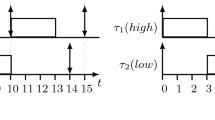Abstract
Real-time systems (RTS) are omnipresent in several domains. The trend is to use multiprocessor architecture to satisfy the timing constraints of such systems. The model-checking methods have proven to be useful for making the development process reliable at a high abstraction level. Based on this approach, the present paper proposes a new technique for scheduling analysis of a partitioned multiprocessor RTS. Starting from a model with dynamic priority time Petri Nets modeling the system, we have proposed a generation of a reduced states graph. Thus, through the properties of the graph the schedulability is checked. Our approach provides an implementation of a Partition Checker tool, which produces an affirmation of the schedulability or a counterexample in the case of non-schedulable system to reduce the SW/HW space exploration.








Similar content being viewed by others
References
Amnell T, Fersman E, Mokrushin L, Pettersson P, Wang Y (2002) Times—a tool for modelling and implementation of embedded systems. In: TACAS ’02: Proceedings of the 8th international conference on tools and algorithms for the construction and analysis of systems. Springer, London, pp 460–464
Antti V (1989) Stubborn sets for reduced state space generation. In: Applications and theory of Petri Nets, pp 491–515
Berthomieu B, Diaz M (1991) Modeling and verification of time dependent systems using time petri nets. IEEE Trans Softw Eng 17(3):259–273
Berthomieu B, Peres F, Vernadat F (2006) Bridging the gap between timed automata and bounded time petri nets. In: FORMATS, pp 82–97
Berthomieu B, Vernadat F (2006) Time petri nets analysis with tina. In: QEST, pp 123–124
Bertogna M, Baruah SK (2011) Tests for global EDF schedulability analysis. J Syst Archit Embed Syst Design 57(5):487–497
Buy U, Sloan RH (1994) Analysis of real-time programs with simple time petri nets. In: ISSTA ’94: Proceedings of the 1994 ACM SIGSOFT international symposium on software testing and analysis. ACM, New York, pp 228–239
Bause F (1997) Analysis of petri nets with a dynamic priority method. In: Azéma Pierre, Balbo Gianfranco (eds) Application and theory of petri nets 1997, vol 1248., Lecture Notes in Computer ScienceSpringer, Berlin, pp 215–234
Carpenter J, Funk S, Holman P, Srinivasan A, Anderson J, Baruah S (2004) A categorization of real-time multiprocessor scheduling problems and algorithms. In: Handbook on scheduling algorithms methods, and models. Chapman Hall/CRC, Boca
Gardey G, Lime D, Magnin M, Roux OH (2005) Romeo: a tool for analyzing time petri nets. In: CAV, pp 418–423
Gonzalez Harbour M, Gutierrez Garciia JJ, Palencia Gutierrez JC, Drake Moyano JM (2001) Mast: modeling and analysis suite for real time applications. Euromicro conference on real-time systems, p 0125
Goossens J, Richard P; Université Libre De Bruxelles (2004) Overview of real-time scheduling problems. In: Euro workshop on project management and scheduling
Hadj Kacem Y, Karamti W, Mahfoudhi A, Abid M (2010) A petri net extension for schedulability analysis of real time embedded systems. In: PDPTA, pp 304–314
Karamti W, Mahfoudhi A, Hadj Kacem Y (2012) Hierarchical modeling with dynamic priority time petri nets for multiprocessor scheduling analysis. In: ESA, the 2012 international conference on embedded systems and applications, pp 114–121
Karamti W, Mahfoudhi A, Hadj Kacem Y (2012) Using dynamic priority time petri nets for scheduling analysis via earliest deadline first policy. In: ISPA, Madrid, pp 332–339
Karamti W, Mahfoudhi A, Hadj Kacem Y, Abid M (2012) A formal method for scheduling analysis of a partitioned multiprocessor system: dynamic priority time petri nets. In: PECCS, Italy, pp 317–326
Kato S, Yamasaki N (2011) Global edf-based scheduling with laxity-driven priority promotion. J Syst Archit Embed Syst Design 57(5):498–517
Kimmo V (1994) On combining the stubborn set method with the sleep set method. In: Valette R (ed) Application and theory of petri nets 1994: proceedings of 15th international conference, Zaragoza, volume 815 of Lecture Notes in Computer Science, Spain. Springer, Berlin, pp 548–567
Kwang SH, Leung JY-T (1988) On-line scheduling of real-time tasks. In: IEEE real-time systems symposium, pp 244–250
Lime D, Roux OH (2009) Formal verification of real-time systems with preemptive scheduling. Real-Time Syst 41(2):118–151
Lime D, Roux OH (2004) A translation based method for the timed analysis of scheduling extended time petri nets. In: RTSS ’04: proceedings of the 25th IEEE international real-time systems symposium. IEEE Computer Society, Washington, DC, pp 187–196
Liu CL, Layland JW (1973) Scheduling algorithms for multiprogramming in a hard-real-time environment. J ACM 20:46–61
Object Management Group (OMG) (2008) A UML profile for MARTE: modeling and analysis of real-time embedded systems, beta 2, ptc/2008-06-09. Object Management Group
Sha L, Abdelzaher T, Arzén KE, Cervin A, Baker T, Burns A, Buttazzo G, Caccamo M, Lehoczky J, Mok KA (2004) Real time scheduling theory: a historical perspective. Real Time Syst 28:101–155
Mahfoudhi A, Hadj Y, Karamti KW, Abid M (2012) Compositional specification of real time embedded systems by priority time petri nets. J Supercomput 59(3):1478–1503
Merlin PM (1974) A study of the recoverability of computing systems. PhD Thesis, Univ. California, Irvine. Available from Univ Microfilms, Ann Arbor, No. 75-11026
Petri CA (1962) Fundamentals of a theory of asynchronous information flow. In: IFIP congress, pp 386–390
Roux OH, Déplanche AM (2002) A t-time Petri net extension for real time-task scheduling modeling. Eur J Autom (JESA) 36(7):973–987
Schmidt DC (2006) Model-driven engineering. IEEE Comput 39(2)
Singhoff F, Legrand J, Nana LT, Marcé L (2004) Cheddar: a flexible real time scheduling framework. ACM Ada Lett J 24(4):1–8. ACM Press, ISSN :1094-3641
Tmar H, Diguet JP, Azzedine A, Abid M, Philippe JL (2006) Rtdt: a static qos manager, rt scheduling, hw/sw partitioning cad tool. Microelectron J 37(11):1208–1219
Triviño F, Sánchez JL, Alfaro FJ, Flich J (2012) Network-on-chip virtualization in chip-multiprocessor systems. J Syst Archit Embed Syst Design 58(3–4):126–139
Veloso M, Pagello E, Kitano H (eds) (2000) Robocup-99: Robot Soccer World Cup III
Author information
Authors and Affiliations
Corresponding author
Rights and permissions
About this article
Cite this article
Karamti, W., Mahfoudhi, A. Scheduling analysis based on model checking for multiprocessor real-time systems. J Supercomput 68, 1604–1629 (2014). https://doi.org/10.1007/s11227-014-1127-8
Published:
Issue Date:
DOI: https://doi.org/10.1007/s11227-014-1127-8




